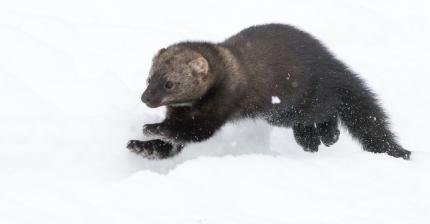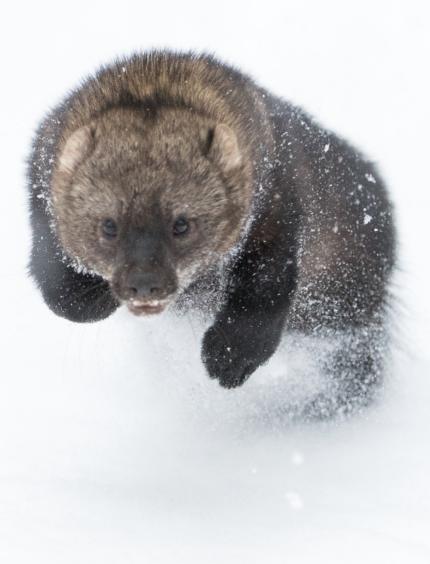ARCHIVED NEWS RELEASE
This document is provided for archival purposes only. Archived documents
do not reflect current WDFW regulations or policy and may contain factual
inaccuracies.
News release Jan. 10, 2020
Washington Department of Fish and Wildlife; Jason Wettstein, jason.wettstein@dfw.wa.gov; 360-902-2254
Conservation Northwest, Chase Gunnell, cgunnell@conservationnw.org, 206-465-8591
Mount Rainier National Park, Kevin Bacher, kevin_bacher@nps.gov, 360-569-6567
Calgary Zoo, Alison Archambault; mediarelations@calgaryzoo.com, 403-919-9482
USDA - Forest Service, Colton Whitworth, colton.whitworth@usda.gov, 425-783-6050

Latest release marks culmination of multi-year partnership between state, federal and non-profit organizations to restore elusive mammal to Washington
Mount Rainier National Park, WA– State, non-profit and federal biologists released four fishers today in the Nisqually River watershed of Mount Rainier National Park. Overall, the partnership led by the Washington Department of Fish and Wildlife (WDFW), the National Park Service (NPS), and Conservation Northwest has now met their goal of releasing more than 250 fishers in the Cascade Range and Olympic Peninsula, completing the final phase of a reintroduction program that began in 2008.
Fishers, a housecat-sized member of the weasel family, were eliminated from Washington by the mid-1900s through over-trapping and habitat loss. They have been listed as a state-endangered species since 1998.
Experts working on the Washington State Fisher Recovery Plan determined that a self-sustaining population was not likely to become re-established in the state without human intervention and that re-introductions were the only means of recovery in western Washington.
The return of fishers to the Cascade Range marks a significant turnabout after their loss from the region for some 75 years.
Since 2008, state, federal, and partner biologists have released 85 fishers in the North Cascades region, 90 on the Olympic Peninsula, and 81 in the South Cascades, a significant step toward recovering the species in Washington.
“Our work this year represents progress in the collective effort to recover fishers in Washington,” said WDFW
biologist Jeff Lewis. “People have been working tirelessly to restore this mysterious and rare carnivore to the Cascades, and now that reintroductions are complete, we think it’s likely that fishers will continue to settle into the recovery areas, find mates, and provide the foundation for a large, healthy population in Washington.”
Follow-up monitoring via cameras and hair snare stations will be deployed over several years allowing

partners to track re-establishment and recovery in Washington, he adds.
The public can also add their observations and sightings of fishers via WDFW's wildlife observations webpage.
A video produced earlier this year by WDFW documents the third fisher reintroduction of the season in the North Cascades and provides additional information about fisher recovery in Washington.
This year’s fisher releases continue the work of a broad public-private collaboration aimed to down-list and ultimately recover the species in Washington. Numerous First Nations and American Indian tribal partners provided crucial support throughout the life of the project. The first and final releases of fishers in the South Cascades occurred in the Nisqually Indian Tribe’s Designated Use Area in Mount Rainier National Park.
“By restoring fishers to Washington State, we’re restoring both our natural and cultural heritage for the enjoyment, education and inspiration of this and future generations,” said Tara Chestnut, Mount Rainier National Park ecologist.
In addition to state, federal, nonprofit, tribal, and international partner organizations, 58 private landowners with 3.03 million acres of forest have joined voluntary Candidate Conservation Agreements with Assurances (CCAA) that provide important habitat for fisher reintroduction and recovery efforts.
The fishers released in Washington were humanely live-trapped in Canada with coordination by Conservation Northwest and with support from The Calgary Zoo, local trappers, First Nations, Canadian Provincial Ministries, and veterinarians.
Fishers released on the Olympic Peninsula and in the South Cascades originally came from British Columbia. After large fires there in 2017, fisher acquisition shifted to Alberta, where their population is robust. Obtaining fishers from two separate source populations is expected to boost genetic diversity in the reintroduced population.
“Our Canadian partners have been vital to the success of this effort, and we deeply appreciate their support,” said Dave Werntz, Conservation Northwest Science and Conservation Director. “We’ve got a great team up north, and they really care a lot about the animals, our restoration goals, and the scientific information that this collaborative restoration project is generating.”
Support and funding for fisher re-introductions comes from numerous sources, including WDFW, NPS, Conservation Northwest, The Calgary Zoo, the US Fish and Wildlife Service, Point Defiance Zoo & Aquarium, Northwest Trek Wildlife Park, the US Forest Service, Washington’s National Park Fund, Pittman-Robertson Funds and State Wildlife Grants, and State Personalized License Plates, among others.